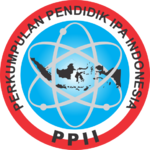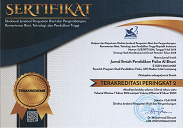Critical thinking in physics: Momentum critical thinking test for pre-service teacher
Abstract
Keywords
Full Text:
PDFReferences
Agustini, R., & Suyatna, A. (2018). Developing inquiry-based practice equipment of heat conductivity to foster the students’ critical thinking ability, 07(1), 49–57. https://doi.org/10.24042/jipfalbiruni.v7i1.1848
Aloisi, C., & Callaghan, A. (2018). Threats to the validity of the collegiate learning assessment ( CLA + ) as a measure of critical thinking skills and implications for learning gain. Higher Education Pedagogies, 3(1), 137–162. https://doi.org/10.1080/23752696.2018.1449128
Anderson, R. G., Knobloch, N., Lambert, M., Saucier, R., Christiansen, J., Dibenedetto, C. A., … Wang, H. (2018). Instrument validity in manuscripts. Journal of Agricultural Education, 59(3).
Ayuningtias, M. D., Suyatna, A., Suyanto, E., & Nwineh, L. (2018). development of lcds-based interactive electronic school book on blackbody radiation as self-instructional materials for fostering student’s critical thinking, 07(October), 183–193. https://doi.org/10.24042/jipfalbiruni.v7i2.2518
Bassett, M. H. (2016). Teaching critical thinking without (much) writing : Multiple-choice and metacognition, 19(1), 20–40.
Bensley, D. A., Rainey, C., Murtagh, M. P., Flinn, J. A., Maschiocchi, C., Bernhardt, P. C., & Kuehne, S. (2016). Closing the assessment loop on critical thinking : The challenges of multidimensional testing and low test-taking motivation. Thinking Skills and Creativity, 21, 158–168. https://doi.org/10.1016/j.tsc.2016.06.006
Borg, W. R., & Gall, M. D. (2007). Educational research: An introduction. London: Longman.
Bryce, T. G. K., & Macmillan, K. (2009). Momentum and kinetic energy : Confusable concepts in secondary school physics, 46(7), 739–761. https://doi.org/10.1002/tea.20274
Carlgren, T. (2013). Communication, critical thinking, problem solving : a suggested course for all high school students. Interchange, 44, 63–81. https://doi.org/10.1007/s10780-013-9197-8
Chou, T., Wu, J., & Tsai, C. (2018). Research trends and features of critical thinking studies in e-learning environments: A review. Journal of Educational Computing Research,. https://doi.org/10.1177/0735633118774350
Crenshaw, P., Hale, E., & Harper, S. L. (2011). Producing intellectual labor in the classroom : The utilization of a critical. Journal of College Teaching & Learning, 8(7), 13–26. https://doi.org/https://doi.org/10.19030/tlc.v8i7.4848
Dega, B. G. (2019). Cognitive diagnostic assessment of students responses: An example from energy and momentum concepts. European Journal of Physics Education, 10(1), 13–23.
Dega, B. G., & Govender, N. (2016). Assessment of students’ scientific and alternative conceptions of energy and momentum using concentration analysis assessment of students’ scienti fi c and alternative. African Journal of Research in Mathematics, Science and Technology Education, 20(3), 1–13. https://doi.org/10.1080/18117295.2016.1218657
Diyanahesa, N. E.-H., Kusairi, S., & Latifah, E. (2017). Development of misconception diagnostic test in momentum and impulse using isomorphic problem. Journal of Physics: Theories and Applications, 1(2), 145–156.
Dobozy, E. (2012). Failed innovation implementation in teacher education: A case analysis. Problems of Education in the 21st Century, 40, 35–44.
Dyer, K. D., & Hall, R. E. (2019). Effect of critical thinking education on epistemically unwarranted beliefs in college students. Research in Higher Education, 60(3), 293-314. https://doi.org/10.1007/s11162-018-9513-3
Ennis, R. H., & Millman, J. (2005). Cornell critical thinking test: Level Z, Seaside, CA: The Critical Thinking Co. formerly Midwest Publications.
Fern, D., Poblete, M., & Galindo-dom, H. (2019). Methodologies for teaching-learning critical thinking in higher education: The teacher’s view. Thinking Skills and Creativity, 33. https://doi.org/10.1016/j.tsc.2019.100584
Franco, A. R., Costa, P. S., & Almeida, S. (2018). Translation, adaptation, and validation of the halpern critical thinking assessment to portugal: Effect of disciplinary area and academic level on critical thinking. Annals of Psychology, 34(2), 292–298.
Greenstein, L. M. (2012). Assessing 21st century skills: A guide to evaluating mastery and authentic learning. California: Corwin Press.
Halpern, D. F. (2014). Critical thinking across the curriculum: A brief edition of thought & knowledge (5th ed.). New York: Routledge.
Irwanto, I., Rohaeti, E., & Prodjosantoso, A. K. (2018). A survey analysis of pre- service chemistry teachers’ critical thinking skills. Journal of Educational Studies, Trends and Practices, 8(1), 57–73.
Janssen, E. M., Meulendijks, W., Mainhard, T., Verkoeijen, P. P. J. L., Heijltjes, A. E. G., Peppen, L. M. Van, & Gog, T. Van. (2019). Identifying characteristics associated with higher education teachers’ cognitive reflection test performance and their attitudes towards teaching critical thinking. Teaching and Teacher Education, 84, 139–149. https://doi.org/10.1016/j.tate.2019.05.008
Kola, M., Rauscher, W., & Haupt, G. (2019). Grade 9 technology teachers’ explication of critical thinking and its enactment in the classroom grade 9 technology teachers’ explication of critical. African Journal of Research in Mathematics, Science and Technology Education, 0(0), 1–12. https://doi.org/10.1080/18117295.2019.1601457
Kristoffer, L. (2017). Understanding and teaching critical thinking — A new approach, 84(May), 32–42. https://doi.org/10.1016/j.ijer.2017.05.004
Kumar, R., Zhi-gang, Z., & Livadiotis, G. (2016). The learning reconstruction of particle system and linear momentum conservation in introductory physics course the learning reconstruction of particle system and linear momentum conservation in introductory physics course. Journal of Physics: Conference Series, 739. https://doi.org/10.1088/1742-6596/739/1/012111
Lin, S. (2014). Science and non-science undergraduate students ’ critical thinking and argumentation performance in reading a science news report. International Journal of Science and Mathematics Education, 12(5), 1023–1045.
Morris, R. J., Brockner, A. E., Coleman, S. E., & Morris, R. J. (n.d.). Effectiveness of two methods for teaching critical thinking to communication sciences and disorders undergraduates. Canadian Journal of Speech-Language Pathology & Audiology, 43(1).
Morris, R. J., Gorham-rowan, M. M., Robinson, J. H., Morris, R. J., & Scholz, K. (2018). Assessing and teaching critical thinking in communication science and disorders assessing and teaching critical hinking in communication science and disorders. Teaching and Learning in Communication Science & Disorders, 2(1).
Negoro, R. A., Susanto, H., & Rusilowati, A. (2017). Pengembangan media pembelajaran fotonovela berbantuan audio materi bunyi untuk siswa tunarungu SMP LB/MTs LB. Unnes Physics Education Journal, 6(2).
Richardson, J. (2011). Tune in to what the new generation of teachers. Phi Delta Kappan, 92(8), 1–6. https://doi.org/https://doi.org/10.1177/003172171109200804
Rosefsky, A. (2012). Learning 21st century skills requires 21st century teaching. Phi Delta Kappan, 94(2), 8–10.
Shavelson, R. J., Zlatkin-troitschanskaia, O., Beck, K., & Marino, J. P. (2019). Assessment of university students’ critical thinking : next generation performance assessment assessment of university students’ critical thinking : next generation performance assessment. International Journal of Testing, 0(0), 1–20. https://doi.org/10.1080/15305058.2018.1543309
Sherblom, P. (2010). Creating critically thinking educational leaders with courage, knowledge and skills to lead tomorrow’s schools today. Journal of Practical Leadership, 5(1), 81–90.
Snyder, S. J., Edwards, L. C., & Sanders, A. L. (2019). An empirical model for infusing critical thinking into higher education. Journal on Excellence in College Teaching, 30, 127–156.
Stobaugh, R. (2013). Assessing critical thinking in middle and high schools: Meeting the Common Core. New York: Routledge.
Sustekova, E. (2019). Validation of critical thinking test on slovak conditions. EURASIA Journal of Mathematics, Science and Technology Education, 15(12).
Tang, K. N. (2018). The importance of soft skills acquisition by teachers in higher education institutions. Kasetsart Journal of Social Sciences, 2–7. https://doi.org/10.1016/j.kjss.2018.01.002
Tiruneh, D. T., & Cock, M. De. (2018). Designing learning environments for critical thinking : Examining effective instructional approaches, 1065–1089. https://doi.org/10.1007/s10763-017-9829-z
Tiruneh, D. T., De Cock, M., Weldeslassie, A. G., Elen, J., & Janssen, R. (2017). Measuring critical thinking in physics: Development and validation of a critical thinking test in electricity and magnetism. International Journal of Science and Mathematics Education, 15(4), 663–682. https://doi.org/10.1007/s10763-016-9723-0
Tiruneh, D. T., Weldeslassie, A. G., Kassa, A., Tefera, Z., Cock, M., & Elen, J. (2016). specific and domain-general critical thinking skills. Educational Technology Research and Development, 64(3), 481–505. https://doi.org/10.1007/s11423-015-9417-2
Triyani, G., Danawan, A., Suyana, I., & Kaniawati, I. (2019). An investigation of students misconceptions about momentum and impulse through interactive conceptual Instruction (ICI) with computer simulation. In Journal of Physics: Conference Series (Vol. 1280, p. 52008).
Utriainen, J., Marttunen, M., Kallio, E., & Tynjälä, P. (2016). University applicants’ critical thinking skills : the case of the finnish educational sciences university applicants’ critical thinking skills : The case of the scandinavian Journal of Educational Research, 61(6), 629–649. https://doi.org/10.1080/00313831.2016.1173092
Verburgh, A. (2019). Studies in higher education effectiveness of approaches to stimulate critical thinking in social work curricula. Studies in Higher Education, 0(0), 1–12. https://doi.org/10.1080/03075079.2019.1586336
Walsh, C., Quinn, K. N., Wieman, C., & Holmes, N. G. (2019). Quantifying critical thinking: Development and validation of the physics lab inventory of Critical thinking (PLIC), 1–16.
Yamanaka, S., Inoshita, H. K., & Aehara, T. M. (2018). A Study on training of critical thinking attitude in high school chemistry through instruction focusing on argumentation. Japan Journal of Educational Technology, 33(4), 411–422.
Yu, K. (2017). The Development and validation of a mechanical critical thinking scale for high school students, 8223(5), 1361–1376. https://doi.org/10.12973/eurasia.2017.00675a
Zhang, L., & Kim, S. (2018). Critical thinking cultivation in chinese college english classes. English Language Teaching, 11(8), 1–6. https://doi.org/10.5539/elt.v11n8p1.
Yerimadesi, Y., Bayharti, B., Azizah, A., Lufri, L., Andromeda, A., & Guspatni, G. (2019). Effectiveness of acid-base modules based on guided discovery learning for increasing critical thinking skills and learning outcomes of senior high school student. Journal of Physics: Conference Series, 1185(1). https://doi.org/10.1088/1742-6596/1185/1/012151
Yuliati, L., Fauziah, R., & Hidayat, A. (2018). Student’s critical thinking skills in authentic problem based learning. Journal of Physics: Conference Series, 1013(1). https://doi.org/10.1088/1742-6596/1013/1/012025
Zain, A. R., & Jumadi. (2018). Effectiveness of guided inquiry based on blended learning in physics instruction to improve critical thinking skills of the senior high school student. Journal of Physics: Conference Series, 1097(1). https://doi.org/10.1088/1742-6596/1097/1/012015
DOI: http://dx.doi.org/10.24042/jipfalbiruni.v9i1.4834
Refbacks
- There are currently no refbacks.

Jurnal ilmiah pendidikan fisika Al-Biruni is licensed under a Creative Commons Attribution-ShareAlike 4.0 International License.
![]()








